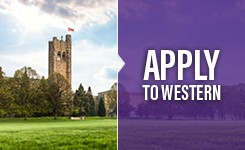How Our EL Credit Works
Guided jointly by a work supervisor and SASAH’s EL Specialist, students undertake an internship or community-engaged-learning (CEL) opportunity in their field of choice in the non-profit, public, or private sector.
Students complete the EL course by participating in:
- 1 Internship – 1.0 credit
- or 1 CEL – 1.0 credit
- or a combination of two such credits worth 0.5 each
Students have several options for finding EL opportunities, including
- applying for an internship with one of SASAH’s partners or an organization through Western Connect or another employment website, or a personal network,
- applying for a CEL with a non-profit partner on their own or, in fourth year, through Student Experience.
Student-found internships, CELs, and independent projects must be proposed and approved before the term in which they are to occur.
SASAH students can find more information on the EL requirement in SASAH’s EL site in OWL or contact Dr. Barbara Bruce at bbruce2@uwo.ca.
EL Course Assignments
The EL curriculum emphasizes the need for students to reflect on and teach others about their experiences.
Students write reflection papers as their opportunities are ongoing and a summative report when it concludes. At the end of the fall and winter terms of their fourth year, students give a presentation about their experiences and then write a final report.
Assignments for independent projects may vary, depending on the nature of the project.
The assignments are designed to encourage students to:
- to analyze and evaluate their experiences,
- to learn about themselves and about types of careers that may be open to them,
- to think about their strengths and skills and how they applied them,
- and to consider if they would want to pursue a career related to their experience.
EL Presentations
Students participate in a Learning from Experience event at the end of the fall or winter term of their fourth (or fifth) year by giving a seven-minute presentation that offers a cogent synopsis of the student’s EL experiences and fielding questions from an audience of peers, supervisors, and guests.
Accompanied by a visual program, created using PowerPoint or equivalent program, that gives evidence of the context(s) of the experience(s) and the respective stages and components, presentations will include:
- a discussion of the goals and outcomes of the internship(s), CEL, or project(s),
- a discussion of the creative and working relationships with the EL partners,
- evidence of tangible results of the experience,
- other information that is relevant and useful to the audience’s understanding of the experience(s).
In presenting on their EL experiences, students develop abilities and skills that are adaptable to postgraduate academic and work environments, such as
- analyzing the positives and negatives of one’s experiences and performance in the workplace,
- articulating and teaching others about their experiences in a succinct and engaging way,
- designing an impactful and effective presentation and
- speaking in public.
After the Learning from Experience event, each student will recreate their presentation using VoiceThread (or equivalent program) to be posted along with their final report on SASAH’s Scholarship@Western page, which “facilitates knowledge sharing and promotes open access to the academic and professional achievements of members of the Western community.”
Getting the EL Credit
In their fourth or fifth year, students will enroll in one 1.0-credit or two 0.5-credit EL courses. There are six EL course numbers to give students options that fit their individual experiences and course load.
Students enroll in:
- 4490F and 4491F if they’ve undertaken two experiences and will finish their EL requirement in the fall.
- 4494W if they’ve undertaken one experience and will finish their EL requirement in the fall.
- 4492G and 4493G if they’ve undertaken two experiences and will finish their EL requirement in the winter.
- 4494X if they’ve undertaken one experience and will finish their EL requirement in the winter.
Before the registration period for their fourth-year courses, SASAH’s EL Coordinator advises students on the course(s) in which they should enroll.
Regardless of when a student has undertaken their EL, the work hours count as the EL course hours. If a student has completed their EL hours before their fourth year, they don’t have any further hours to work for the requirement except for the time they put into creating their final presentation and report, so the 4490x course(s) will be free time in their schedule.
If they have not completed their EL hours, the 4490x course(s) builds time for their EL work into their schedule.
The Assaly Experiential Learning Fund
ARTHUM 3380Y
Workshops
SASAH offers workshops to students in each year of their academic career, with a special emphasis on fourth year, as students prepare to enter the working world. Lasting 1 to 2 hours, workshops are presented by the EL Coordinator and a staff member from Western’s Student Experience office.
Topics of workshops include financial literacy, life design, and the articulation of transferable skills. Third- and fourth-year students attend mock-interview workshops, while fourth-year students also participate in a networking workshop that is attached to the winter-term meeting of the SASAH Advisory Council and thus involves the participation of distinguished Western alumni who are leaders in the cultural, corporate, and non-profit sectors.


